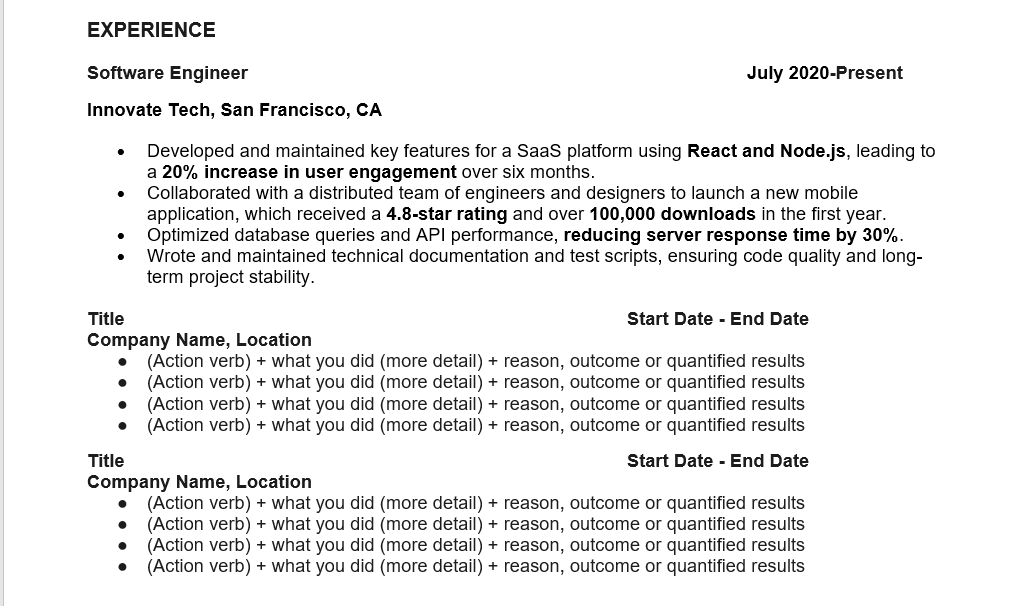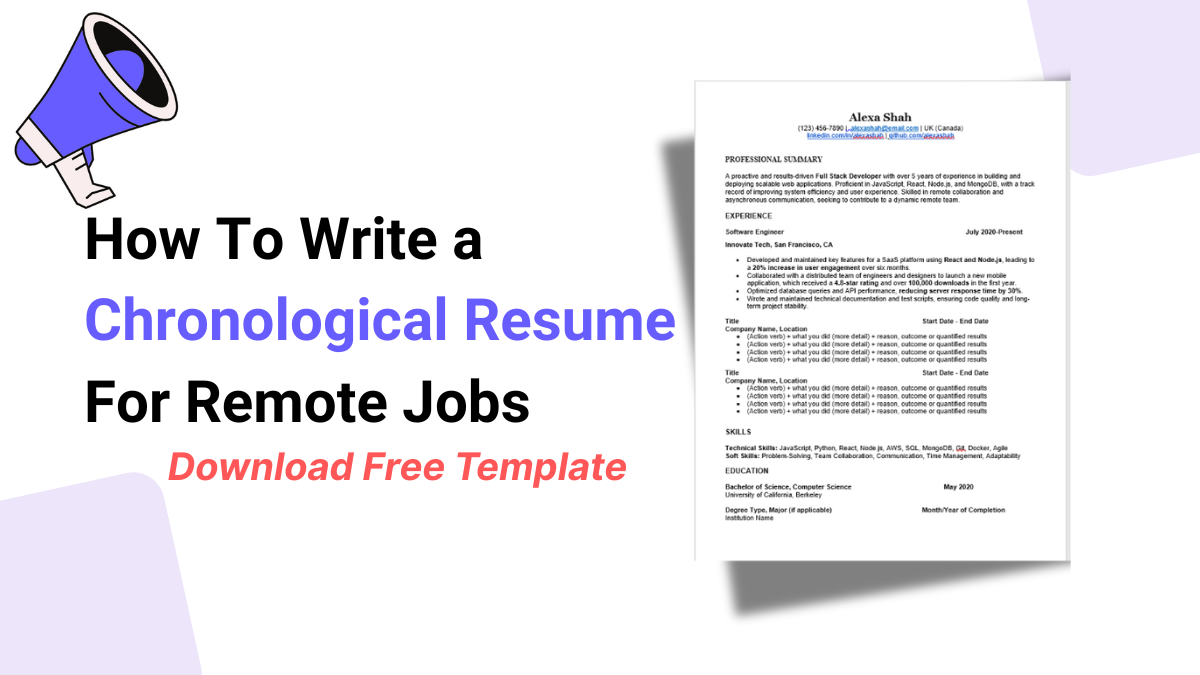The job market is more global than ever, and a well-crafted resume is your key to unlocking remote opportunities. A great chronological resume doesn’t just list your past jobs; it tells a compelling story of your skills, accomplishments, and potential. Whether you’re an experienced professional or a recent graduate, a strong resume can help you stand out from the competition. We’ll walk you through the step-by-step guide of writing a chronological resume plus in the end you’ll get a free downloadable link of chronological resume template.
Chronological Resume Template
1. Contact Information
Your contact information should be clear and easy to find. Make sure it’s accurate and professional.
Example:
Alexa Shah (123) 456-7890 | alexashah@email.com | linkedin.com/in/alexashah | github.com/alexashah | https://www.google.com/search?q=portfolio-website.com

2. Professional Summary
This section is your chance to make a strong first impression. In starting 3-5 sentences, you have to do a summary of your professional experience, career goals, and key skills you have. Be specific in this part of job you’re applying for.
Example:
“A proactive and results-driven Full Stack Developer with over 5 years of experience in building and deploying scalable web applications. Proficient in JavaScript, React, Node.js, and MongoDB, with a track record of improving system efficiency and user experience. Skilled in remote collaboration and asynchronous communication, seeking to contribute to a dynamic remote team.”

3. Experience
This is where you show off your accomplishments. Here you have to Focus on the things you have achieved, not just what you have done. Use the following format for each of your roles.
Example:
Software Engineer
July 2020 – Present
Innovate Tech, San Francisco, CA
- Developed and maintained key features for a SaaS platform using React and Node.js, leading to a 20% increase in user engagement over six months.
- Collaborated with a distributed team of engineers and designers to launch a new mobile application, which received a 4.8-star rating and over 100,000 downloads in the first year.
- Optimized database queries and API performance, reducing server response time by 30%.
- Wrote and maintained technical documentation and test scripts, ensuring code quality and long-term project stability.
Same goes for previous experience.

4. Skills
List your technical and soft skills. Be concise and add keywords exactly from the job description.
Example:
Technical Skills: JavaScript, Python, React, Node.js, AWS, Agile
Soft Skills: Problem-Solving, Adaptability, Communication
P.S. You can also list these in bullet/ Listicle format

5. Education
Provide details about your academic background.
Example:
Bachelor of Science, Computer Science
May 2020
University of California, Berkeley

6. Certifications
Certifications can prove your expertise in specific areas of chronological resume.
Example:
- AWS Certified Solutions Architect – Associate, Amazon Web Services – 2023
- Certified ScrumMaster (CSM), Scrum Alliance – 2022

7. Awards/Recognition/Volunteer Work (Optional)
Include any notable awards, recognition, or volunteer work that showcases your character and commitment.
Example:
- Employee of the Month, Innovate Tech – January 2022
- Volunteer Coder, Non-profit Organization, building a website for a local charity – 2021

8. Reference (optional)
It is a plus point if you add reference in the resume. But since,if you are beginner don’t have any reference then this is not a big deal. Leave this option.
Also if you don’t want to disclose the personal details of that person, then you have to just write “To be furnished upon request.”
Here is the Compete template Link: Download Here

Conclusion
A chronological resume is a living document that should be tailored for each job application. If you showcase your achievements, add numbers to show your impact, and highlight the skills that make you great at working remotely, you can create a resume that stands out and helps you land the remote job you want. Remember to proofread carefully and make sure every section tells a clear story about your value as a candidate.
Read our article on: Balancing Job hunting with Current Employment
FAQs
Q1: How long should my chronological resume be?
A: For most tech roles, a one-page resume is best, especially if you have less than 10 years of experience. A two-page resume is acceptable for senior professionals with extensive experience.
Q2: Is it a good idea to add a photo to my resume?
A: No, it’s generally best to avoid including a photo on your resume. It can lead to unconscious bias and is not a common practice in the U.S. and many other countries.
Q3: What’s the difference between a professional summary and a resume objective?
A: A professional summary is for experienced professionals and summarizes key skills and accomplishments. A resume objective is for recent graduates or career changers and outlines what you hope to achieve in your next role.
Q4: Is it okay to use a chronological resume template?
A: Yes, using a clean and simple template is a great idea. However, avoid overly complex or graphical templates that can be difficult for Applicant Tracking Systems (ATS) to read.
Q5: How important are keywords on a chronological resume?
A: Keywords are very important. Many companies use ATS to screen resumes, and using keywords from the job description helps your resume get past these systems and into the hands of a human recruiter.
